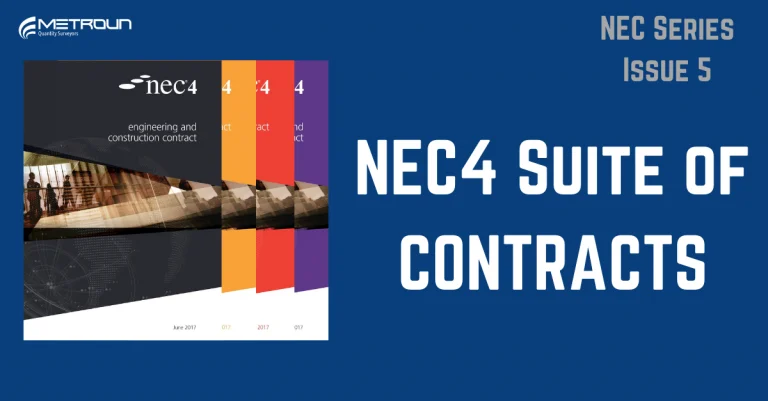The New Engineering Contract (NEC). provides suites of standard forms of procurement processes and main contracts in construction. The first edition of these contracts fell under the umbrella name “NEC” in 1993. Subsequently is evolved into “NEC 2” in 1995, “NEC3” in 2005 and most recently “NEC 4” in 2017. At the time of writing this article, most contracts are currently procured under NEC3. However, it’s anticipated this will likely move to NEC 4 in the next couple of years.

Please click here for our selection of NEC tailored excel templates for download.
The contract forms which fall under the NEC are as follows:
Engineering and Construction Contract (ECC) – This is the most commonly used contract form and contains all the characteristics of the NEC. This contract is mostly used between a main contractor and client. Within this contract there are six options of which the Employer will choose what they believe will achieve the best value:
Option A: Priced contract with activity schedule
Option B: Priced contract with bill of quantities
Option C: Target contract with activity schedule
Option D: Target contract with bill of quantities
Option E: Cost-reimbursable contract
Option F: Management contract
You can find out more about the NEC options here.
The Engineering and Construction Subcontract Contract (ECS) – This contract is very similar to the above. However, it allows for the main contractor to sub-let part of the project to a subcontractor. This allows for back to back clauses. The only difference is a change in names (i.e, contractor and subcontractor) and time scales are altered to facilitate the timesclaes required in the ECC contract.
The Engineering and Construction Short Contract (ECSC) – This contract is a cut down version of the ECC and is to be used when the work carried out is considered to be low risk. Similar to ECC this is for an Employer/Contractor agreement.
The Engineering and Construction Short Subcontract (ECSS) – Back-to-back with the ECSC. However, is to be used for a contractor/sub-contract relation. Like the ESCS this is used when work is considered low risk.
The Professional Services Contract (PSC) – To be used for anyone who provides a service. For example, contractors carrying out design work. This ensures that although the design is produced for a contractor or employer, they would be signed up to follow the clauses within the contract.
The Professional Services Short Contract (PSSC) – For less complex assignments carried out under the PSC. This contract is often used for a small team managing the administration of the ECC on behalf of the Employer.
Framework Contract (FC) – This is an umbrella contract which is used over an agreed length of time. Within that timeframe, work is let under a number of different contracts within the suite. This means parties will adhere to the headline clauses within the framework while following the individual clauses within the chosen contract for that package. The Framework Contract is often very slim compared to the other contracts.
Term Service Contract (TSC) – For a project which is operational or maintenance based. For example, maintaining a highway asset like street lighting. It will be the contractors responsibility to maintain the asset and ensure a certain standard is kept for an agreed length of time. This contract isn’t generally used for constructing new works. There is also a short form version of this contract for low risk work.
Supply Contract/Short Supply Contract (SC/SSC) – This contract is specific for a supplier of supplies or goods. The purpose of the contract is to put a contractual responsibility on the supplier during construction project life cycle. The Supply Contract is for big project specific items which are designed and manufactured specially for that contract. The Short Contract is for more general supply of goods to a project. Neither of these contracts cover site working.
Dispute Resolution Services Contract (DRSC) – previously Adjudicator’s Contract – To be used when there is a dispute between parties on a project. The Adjudicator will follow the clauses within this contract.
Design Build and Operate (DBO) – This allows for a whole-life delivery solution. It combines, design, build and maintenance responsibility for a single contractor.
Alliance Contract (ALC) – This is designed for clients who wish to fully integrate the delivery team for large complex projects. The ALC is used to engage a number of participants in a single collaborative contract to deliver a project or section of works. The basis of this contract is all parties work together in order to achieve the Client objectives while sharing the risk an benefit between them.
Watch our video on NEC Contract cost here:










